Stagecoach Vineyard
by
Terry Sullivan
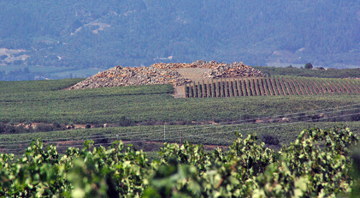 Summary: A twenty-minute drive on a winding road off the Silverado Trail leads you to a world away from Napa. The Stagecoach Vineyards are secluded and offer a paradise amongst the vines.
Summary: A twenty-minute drive on a winding road off the Silverado Trail leads you to a world away from Napa. The Stagecoach Vineyards are secluded and offer a paradise amongst the vines.
History
In the 1800s, the land that now comprises Stagecoach Vineyard was settled by Germans who planted vineyards in the area. The land was also a route for the stagecoach from St. Helena to Monticello. By the early 1900s farmers abandoned viticulture in these hills due to an explosion in the deer population and Prohibition. Several decades passed until Dr. Jan Krupp took an interest in this Napa Valley property, in part because he saw a few old vines growing in the wild.
Dr. Krupp began developing the property in 1995 and it took several years to haul away more than a billion pounds of volcanic rock. Prior to clearing the land, Dr. Krupp looked for a water source. A geologist came up dry, so Dr. Krupp hired a dowser, a water witch, to help locate underground streams. She told him where to drill and after drilling 400 feet deep, a stream was found.
There are close to 600 acres of vineyards making Stagecoach Vineyard one of the largest contiguous vineyards in Napa Valley. Dr. Krupp also planted 500 olive trees. He sells the olives but reaps the benefits of having olive trees near a vineyard. Olive trees attract ladybugs and ladybugs eat aphids.
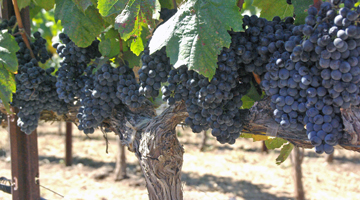 Vineyards
Vineyards
The elevation of the vineyard blocks span 550 feet from a low of 1,200 feet to a high of 1,750 feet. The elevation places the vineyard above the fog line. The grapes express the aromas and flavors associated with rocky soils and minerality.
Stagecoach Vineyard, the largest vineyard in Napa Valley, is on a south facing mountain. There are 16 varietal wine grapes planted in 175 blocks. Of the varieties planted, over half of the vineyard is planted with Cabernet Sauvignon. Together with the Cabernet Sauvignon, Cabernet Franc, Malbec, Merlot and Petit Verdot account for 85% of the varietal grapes planted.
The vineyards are sustainably farmed. Some vineyard practices help the soil such as using permanent cover crops to prevent erosion and planting site-specific cover crops to add nutrients to the soil. Other sustainable practices help insure a balance in the environment including building insect hotels and bird houses. Smart use of water irrigation and the use of local restaurant food wastes for compost are examples of other sustainable practices.
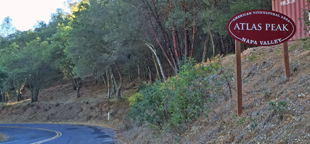 Stagecoach Vineyard covers four distinct areas including the Atlas Peak region, Bordeaux region, Heart of Stagecoach region and Pritchard Hill region. Most of the Atlas Peak region and parts of the Bordeaux and Heart of Stagecoach regions are in the Atlas Peak AVA.
Stagecoach Vineyard covers four distinct areas including the Atlas Peak region, Bordeaux region, Heart of Stagecoach region and Pritchard Hill region. Most of the Atlas Peak region and parts of the Bordeaux and Heart of Stagecoach regions are in the Atlas Peak AVA.
There are 100 fulltime employees working at Stagecoach Vineyard year round. All the grapes are hand harvested and there is plenty of work to be done outside the harvest months.
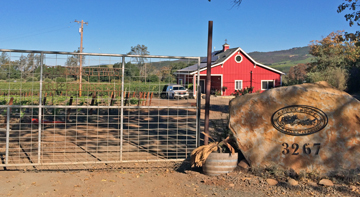 Vineyard Visit
Vineyard Visit
We followed the directions that Stagecoach Vineyard sent us, a plus for finding the location on Soda Canyon Road. Be persistent. We saw a red barn in the distance and slowly pulled up to the gate. There, written on the gate were the words. “Stagecoach VYNDS Krupp Brothers 3267.” Next to the gate is a large brightly colored rock with the stagecoach logo on the center. We waited only a moment at the gate and after it opened, we parked our car next to the barn. Tours of the vineyard are for small groups. There were only six of us on the morning tour.
Therese greeted us. After the others arrived, Therese had us sit at a dining room table and introduce ourselves. She then told us the history of the land and Jan Krupp’s motivation to plant vineyards. We learned that Dr. Krupp purchased 41 acres after reading about the land for sale in the San Francisco Chronicle. So after he acquired the land, an adjacent parcel of 650 acres became available. Jan Krupp, along with other interested buyers, had to fly over the land to see what it looked like. At the time, people were not able to drive to or through the property. From the air, the land was covered with large rocks and chaparral. Others, who looked at the property, decided not to pursue the purchase of the land. Dr. Krupp, however, was not deterred. He worked with a geologist and a dowser to search for water, and an underground stream was discovered.
The next challenge was that there were no roads to the property. Dr. Krupp met with all the neighbors and talked about easement rights. All his neighbors signed onto to building a road. Although it only took a couple of months to build the road, it took a year to clear the area for the roads of rocks and chaparral. Therese mentioned that Dr. Krupp likes to blow thinsg up. Even today he is still tackling rocks.
Our destination through the vineyards was the pavilion near a summit with beautiful views. Just before the turn to the pavilion, there was a small structure housing a stagecoach. Therese commented that there are people who would like to take the tour in the stagecoach. It would be a very rocky ride, however. After arriving at the pavilion we tasted grapes from an adjacent Cabernet Sauvignon row. The grapes were sweet, although there was still pulp around the seeds that could turn browner. In about two weeks, the vineyard workers will harvest the Cabernet Sauvignon. We then sat at tables in the pavilion and tasted some Krupp Brothers' wines.
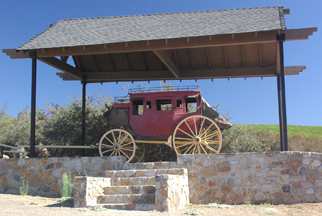
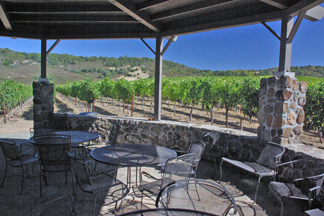
Winemaking
The Krupps Brothers Winery only uses five percent of the grapes from the vineyards. The majority of grapes are sold to wineries. About 93 wineries craft wine from the grapes harvested at Stagecoach Vineyard. Perhaps the most important reason that wineries source fruit from Stagecoach Vineyards is the consistent quality of the fruit every year. We have made wine from Stagecoach fruit in 2009, 2012 and 2014 at Tin Lizzie Wineworks in Clarksville, Maryland. It is almost three thousand miles from the vineyard to the winery. Some people wonder what condition the grapes are in when we receive them.
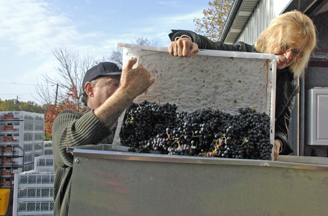 The grapes are transported across the country in refrigerated trucks. They are packed in lugs and the lugs stack on top of each other. As a result, the grapes are not crushed and arrive in pristine condition. We let them warm up a day or so before we destem the grapes and add yeast to the fermentation bin. The Stagecoach Vineyard’s grapes are wonderful to work with as witnessed by the many famous wineries that use the grapes from Stagecoach Vineyard.
The grapes are transported across the country in refrigerated trucks. They are packed in lugs and the lugs stack on top of each other. As a result, the grapes are not crushed and arrive in pristine condition. We let them warm up a day or so before we destem the grapes and add yeast to the fermentation bin. The Stagecoach Vineyard’s grapes are wonderful to work with as witnessed by the many famous wineries that use the grapes from Stagecoach Vineyard.
If you are traveling to Napa, make an appointment for the tour at Stagecoach Vineyard. The views from the pavilion are very photogenic.
Stagecoach Vineyard
3267 Soda Canyon Rd
Napa, California 94558
GPS: N38º 26.322’ W122º 17.641’
Article written September 2014
Visit these California organizations and wineries that partner with Wine Trail Traveler.
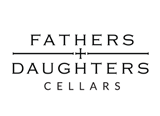 |
|||


